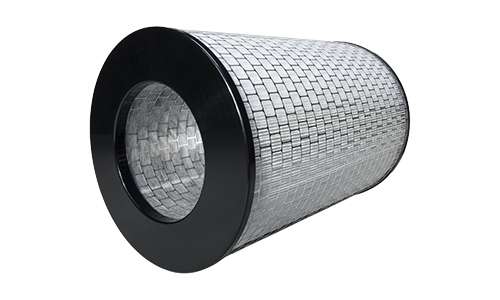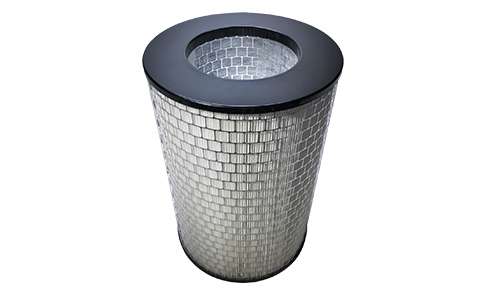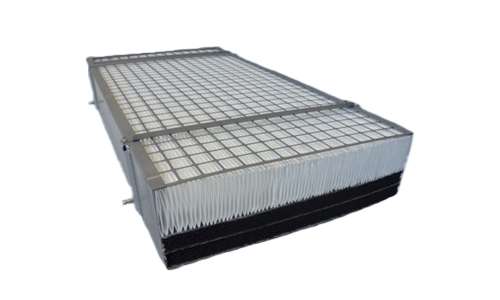Cabin Air Filtration
Enhancing the Cabin Air Quality environment
through advanced filtration solutions
What is Cabin Air Filtration?
Approximately half of the air onboard an aircraft is recirculated and can contain dust, skin flakes, bacteria, and viruses. Coughing, sneezing, and low humidity contribute to the spread of diseases. The other half is engine bleed air, which may contain harmful volatile organic compounds.
Most commercial aircraft have High-Efficiency Particle Air (HEPA) filters that remove 99.97% of contamination. These filters help to create a healthier environment by continuously circulating and purifying the air throughout the flight. Carbon media added to air filters can help reduce odors in the cabin by adsorbing volatile organic compounds (VOCs) and other odor-causing substances. This improves the comfort of passengers during their journey by providing clean and fresh air. The Pall A-CAF (Advanced Cabin Air Filter) eliminates odors and volatile organic compounds (VOCs) that may be present from engine oil and oil degradation, de-icing fluids, and hydraulic fluids ingestion.
Join our tech expert Paul Roux in our video (right) as he explains and shows you around an A320 aircraft to discover how microbial HEPA filtration, combined with carbon media, prioritizes passenger safety, comfort, and sustainability in the aviation industry.
To speak to our team of filtration experts and find out how we can support your cabin air quality requirements, contact us.
Featured Products
A320 Advanced Cabin Air Filter
View Product >
A320 HEPA Cabin Air Filter
View Product >
A330 Advanced Cabin Air Filter
View Product >
Frequently Asked Questions
How do Cabin Air Filters Work in Removing Viruses and Bacteria?
A modern cabin air filter removes particles by utilizing three primary mechanisms. These are:
What is the HEPA filtration efficiency of Pall filters?
Tests by an independent laboratory1 show that Pall HEPA Cabin Air Filters have a microbial removal efficiency of greater than 99.999% with bacteria and viruses. This can be equated to an H13-level classification.
In standard tests, the filters are tested with maximum penetrating sizes. The graph illustrates that particles smaller and larger than the tested size will be removed more efficiently. (Right). The ASHRAE Standard 161-2007 states that HEPA filters should provide a minimum of 99.97% collection efficiency for 0.3 micron particles.
[1] Centre for Applied Microbiology and Research (CAMR), now known as Public Health England.
What is the manufacturing process?
Processes include pleating of the glass fiber HEPA filter media, forming the hardware from sheet aluminum, assembly of the odor and HEPA stages, assembly and sealing into the hardware and efficiency testing every batch.
In HEPA media production, fibers suspended in a liquid are poured over a screen so that the liquid can drain away from the fibers. Quality control checks that the distribution of pore sizes within the fibrous structure is within defined limits. The efficiency of the medium, particularly with smaller particles, is related to the thickness of the fibrous medium, the density of fibers, and the thickness of the individual fibers. Optimizing these three parameters contributes significantly to particle removal via diffusional interception.
What is the recommended filter element change-out interval?
Aircraft manufacturers specify recommended filter element change-out intervals. The time interval varies between aircraft types and between aircraft systems. Pall also works with airlines and aircraft manufacturers to determine the optimum service interval for specific operating environments.
What is the recommended filter element change-out interval in the case of a pandemic?
We recommend following the aircraft/system integrator guidance and any local airworthiness/regulatory guidance. However, the efficiency of a HEPA filter improves with usage. Filters needn't be changed after exposure to contamination until the maximum flight hours or differential pressure is met.
Is there a danger to maintenance personnel in removing the used filters during the sars-cov-2* outbreak?
We recommend following the official WHO and local government guidelines. The above applies to all Pall Aerospace cabin air filters, OEM or IPC-listed filters and any Pall PMA-approved parts.
*World Health Organization, Naming the coronavirus disease (COVID-19) and the virus that causes it (accessed March 2020).
Is there a danger to maintenance personnel when removing used cabin air filters?
Replacement of used HEPA or A-CAF filters carries no greater risk than undertaking general maintenance on any in-service aircraft part. Maintenance staff concerned about the general accumulation of dust or debris on cabin air filters should wear the same personal protective equipment used for similar aircraft maintenance tasks. Contact airline safety and health personnel to advise if specific PPE is required.
Can Pall Filters be returned for analysis of contaminants?
Pall Aerospace have extensively tested and examined numerous new and returned filters. These tests have looked at microbial growth, remaining filter life and also potential Volatile Organic Compound contaminants that may have accumulated due to a fume or odour event. Filters can be returned directly to Pall Aerospace Scientific Laboratories in Portsmouth, UK for further analysis and in an effort to greater support our customers in service.







